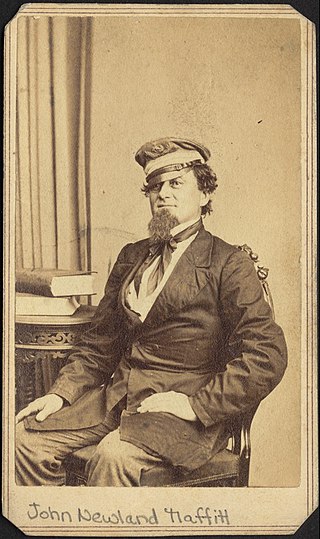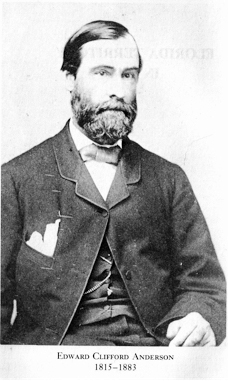
The Confederate States of America (CSA), commonly referred to as the Confederate States (C.S.), the Confederacy, or the South, was an unrecognized breakaway republic in the Southern United States that existed from February 8, 1861, to May 9, 1865. The Confederacy comprised eleven U.S. states that declared secession and warred against the United States during the American Civil War. The states were South Carolina, Mississippi, Florida, Alabama, Georgia, Louisiana, Texas, Virginia, Arkansas, Tennessee, and North Carolina.

CSS Florida was a sloop-of-war in the service of the Confederate States Navy. She served as a commerce raider during the American Civil War before being sunk in 1864.

John Newland Maffitt was an officer in the Confederate States Navy who was nicknamed the "Prince of Privateers" due to his success as a blockade runner and commerce raider in the U.S. Civil War.

CSSOwl was a blockade runner in the Confederate States Navy during the American Civil War. It was built by Jones Quiggen, a ship builder in Liverpool, England and launched on June 21, 1864.

The Confederate Powderworks was a gunpowder factory during the American Civil War, the only permanent structures completed by the Confederate States of America. Colonel George Washington Rains chose the old United States Arsenal site between the Augusta Canal and Savannah River in Augusta, Georgia, as a secure inland location with good rail and water connections.

Charles Manigault Morris was an officer in the United States Navy and later in the Confederate States Navy. Morris was a descendant of several of the most prominent Northern and Southern families in colonial America.

John Taylor Wood was an officer in the United States Navy and the Confederate Navy. He resigned from the U.S. Navy at the beginning of the American Civil War, and became a "leading Confederate naval hero" as a captain in the Confederate Navy. He was a lieutenant serving aboard CSS Virginia when it engaged USS Monitor in 1862, one of the most famous naval battles in Civil War and U.S. Naval history. He was caught in 1865 in Georgia with Confederate President Jefferson Davis' party, but escaped and made his way to Cuba. From there, he got to Halifax, Nova Scotia, where he settled and became a merchant. His wife and children joined him there, and more children were born in Canada, which is where he lived out the remainder of his life.

Richard Peters was an American railroad man and a founder of Atlanta, Georgia, in the 1840s.
CSS Savannah, later called Old Savannah and Oconee, was a gunboat in the Confederate States Navy during the American Civil War.
The Crenshaw Company was a blockade running company established during the American Civil War.

USS Crusader was a screw steamer of the United States Navy that served prior to, and during, the American Civil War.

Joseph Nicholson Barney was a career United States Navy officer (1835–1861) who served in the Confederate States Navy in the American Civil War (1861–1865).

Georgia was one of the original seven slave states that formed the Confederate States of America in February 1861, triggering the U.S. Civil War. The state governor, Democrat Joseph E. Brown, wanted locally raised troops to be used only for the defence of Georgia, in defiance of Confederate president Jefferson Davis, who wanted to deploy them on other battlefronts. When the Union blockade prevented Georgia from exporting its plentiful cotton in exchange for key imports, Brown ordered farmers to grow food instead, but the breakdown of transport systems led to desperate shortages.
The Georgiana was a brig-rigged, iron hulled, propeller steamer belonging to the Confederate States Navy during the American Civil War. Reputedly intended to become the "most powerful" cruiser in the Confederate fleet once her guns were mounted, she was never used in battle. On her maiden voyage from Scotland, where she was built, she encountered Union Navy ships engaged in a blockade of Charleston, South Carolina, and was heavily damaged before being scuttled by her captain. The wreck was discovered in 1965 and lies in the shallow waters of Charleston's harbor.
The bibliography of the American Civil War comprises books that deal in large part with the American Civil War. There are over 60,000 books on the war, with more appearing each month. Authors James Lincoln Collier and Christopher Collier stated in 2012, "No event in American history has been so thoroughly studied, not merely by historians, but by tens of thousands of other Americans who have made the war their hobby. Perhaps a hundred thousand books have been published about the Civil War."
William Norwood Still Jr. was an American maritime historian. He was the first director of the program in maritime history at East Carolina University and a noted author of works on U.S. Civil War history and U.S. naval history.

During the American Civil War, blockade runners were used to get supplies through the Union blockade of the Confederate States of America that extended some 3,500 miles (5,600 km) along the Atlantic and Gulf of Mexico coastlines and the lower Mississippi River. The Confederacy had little industrial capability and could not indigenously produce the quantity of arms and other supplies needed to fight against the Union. To meet this need, numerous blockade runners were constructed in the British Isles and were used to import the guns, ordnance and other supplies that the Confederacy desperately needed, in exchange for cotton that the British textile industry needed greatly. To penetrate the blockade, these relatively lightweight shallow draft ships, mostly built in British shipyards and specially designed for speed, but not suited for transporting large quantities of cotton, had to cruise undetected, usually at night, through the Union blockade. The typical blockade runners were privately owned vessels often operating with a letter of marque issued by the Confederate government. If spotted, the blockade runners would attempt to outmaneuver or simply outrun any Union Navy warships on blockade patrol, often successfully.

Historical accounts for early U.S. naval history now occur across the spectrum of two and more centuries. This Bibliography lends itself primarily to reliable sources covering early U.S. naval history beginning around the American Revolution period on through the 18th and 19th centuries and includes sources which cover notable naval commanders, Presidents, important ships, major naval engagements and corresponding wars. The bibliography also includes sources that are not committed to the subject of U.S. naval history per se but whose content covers this subject extensively.

Edward Clifford Anderson Sr. was a naval officer in the United States Navy, Mayor of Savannah, Georgia and a Colonel in the Confederate States Army during the American Civil War. He commanded Fort James Jackson near Savannah before its capture in 1864. He was elected mayor of Savannah eight times, before and after the war, and on December 6, 1865, he became the first mayor after the civil war.
Sir John Campbell Lees was an English lawyer and colonial judge.














